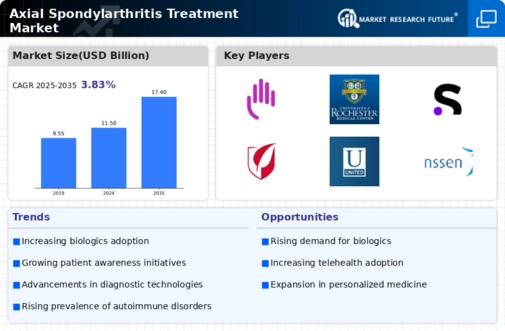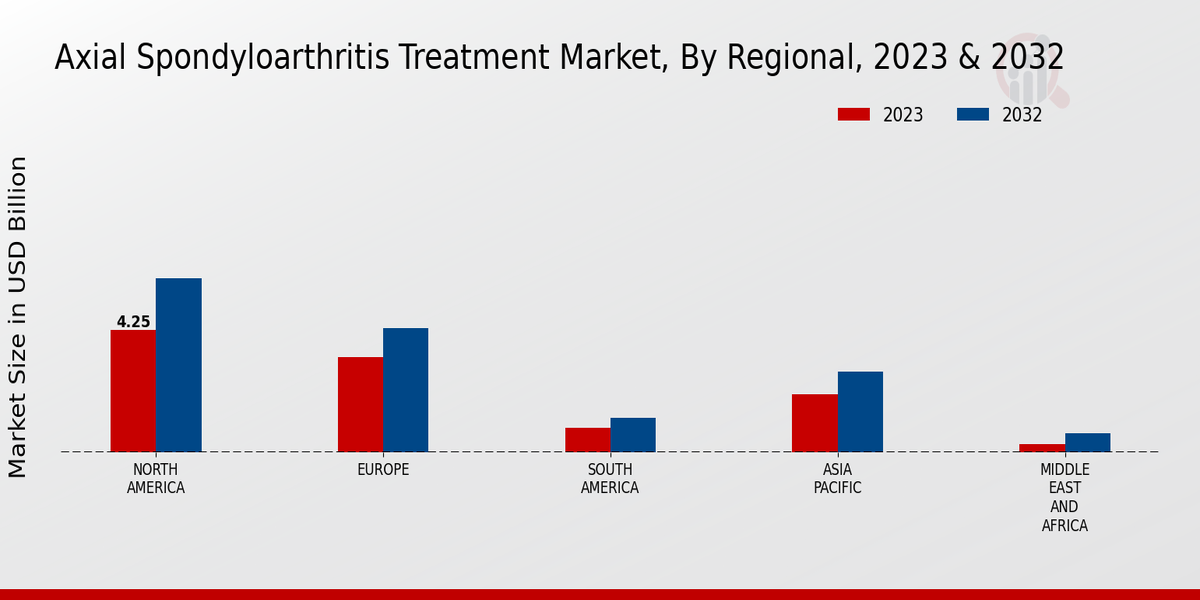Market Growth Projections
The Global Axial Spondylarthritis Treatment Market Industry is projected to experience substantial growth over the next decade. With a market value anticipated to reach 11.5 USD Billion by 2024 and 17.4 USD Billion by 2035, the industry is poised for significant expansion. The compound annual growth rate (CAGR) of 3.83% from 2025 to 2035 indicates a steady increase in demand for treatment options. This growth can be attributed to various factors, including rising prevalence rates, advancements in treatment modalities, and increased healthcare expenditure. The market's trajectory suggests a robust future, with ongoing innovations likely to enhance patient care and treatment outcomes.
Growing Awareness and Education
The rise in awareness and educational initiatives surrounding axial spondylarthritis is a crucial driver of the Global Axial Spondylarthritis Treatment Market Industry. Organizations and healthcare providers are increasingly focusing on educating both patients and healthcare professionals about the disease, its symptoms, and available treatment options. This heightened awareness leads to earlier diagnosis and treatment, which is essential for managing the condition effectively. Campaigns aimed at promoting understanding of AS are likely to contribute to increased patient engagement and treatment adherence. Consequently, this trend is expected to support market growth, as more patients seek appropriate therapies to manage their condition.
Increased Healthcare Expenditure
Rising healthcare expenditure across the globe is a significant factor propelling the Global Axial Spondylarthritis Treatment Market Industry. Governments and private sectors are investing more in healthcare infrastructure and services, which facilitates access to advanced treatment options for patients. For instance, countries with robust healthcare systems are increasingly adopting new therapies, thereby enhancing patient outcomes. This trend is particularly evident in developed nations, where healthcare spending is projected to grow at a steady rate. As a result, the market is expected to experience a compound annual growth rate (CAGR) of 3.83% from 2025 to 2035, reflecting the ongoing commitment to improving healthcare delivery.
Advancements in Treatment Modalities
Innovations in treatment modalities significantly influence the Global Axial Spondylarthritis Treatment Market Industry. The introduction of biologic therapies and targeted treatments has transformed patient management, offering improved outcomes. For instance, tumor necrosis factor (TNF) inhibitors have shown efficacy in reducing inflammation and improving quality of life for patients. Furthermore, ongoing research into Janus kinase (JAK) inhibitors and other novel agents suggests a promising future for treatment options. As these advancements continue to emerge, they are likely to drive market growth, with projections indicating a market value of 17.4 USD Billion by 2035, highlighting the potential for continued innovation in this field.
Regulatory Support for New Therapies
Regulatory bodies are playing an essential role in facilitating the development and approval of new therapies for axial spondylarthritis, thus impacting the Global Axial Spondylarthritis Treatment Market Industry. Streamlined approval processes and incentives for research and development encourage pharmaceutical companies to invest in innovative treatments. For example, the designation of orphan drug status for certain therapies can expedite their availability to patients. This supportive regulatory environment is likely to enhance the market landscape, fostering competition and driving advancements in treatment options. As a result, the market is poised for growth, with an increasing number of therapies entering the market.
Rising Prevalence of Axial Spondylarthritis
The increasing incidence of axial spondylarthritis (AS) globally is a primary driver of the Global Axial Spondylarthritis Treatment Market Industry. Recent studies indicate that AS affects approximately 0.1% to 1.4% of the population in various regions, with higher rates observed in certain demographics. This growing prevalence necessitates effective treatment options, contributing to the market's expansion. As awareness of the condition rises, more individuals seek medical attention, leading to increased demand for therapies. The market is projected to reach 11.5 USD Billion by 2024, reflecting the urgent need for innovative treatment solutions to address this chronic condition.













